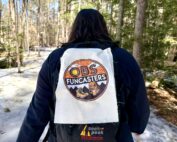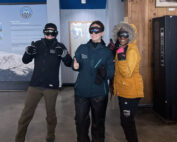Managing Risk in the Mountains with the Higher Summits Forecast
By Carissa Milliman

A group of hikers trek along the open ridges of the White Mountains. Joe Klementovich photo.
With more and more people visiting the White Mountains each year to experience the expansive network of wilderness and enjoy the abundance of recreational opportunities, the ability to easily access an accurate weather forecast is more crucial than ever.
Weather patterns change unexpectedly, dramatically, and quickly. Being prepared means checking the Higher Summits Forecast often and prior to setting out on any adventure.
The process of forecasting and communicating the weather for the day or upcoming weekend is no small feat. It all begins every morning at 5:00 AM when a forecast for the next 48 hours is finalized and shared in a multitude of ways by the Mount Washington Observatory (MWOBS) weather observer on duty.
- At 5:00 AM, the Higher Summits Forecast is uploaded to the MWOBS website in both text and audio format (last month, this forecast was viewed over 51,000 times).
- At 7:00 AM, the observer radios the Appalachian Mountain Club (AMC) hut network to deliver the forecast to the caretakers on duty. The hut caretakers then post the forecast and share it with passing hikers/travelers who may have no other way to access the information.
- At 7:50 AM, a recording is shared via local radio stations, and the observer broadcasts a live forecast on 93.5 WMWV.
- At 3:00 PM, a new Higher Summits Forecast is finalized and published on mountwashington.org.
- Every Friday night, a Facebook Live segment is presented by a MWOBS weather observer, frequently in partnership with the Mount Washington Avalanche Center, to reach and inform a broader audience timed for weekend recreation.
- The forecast is also available on demand, 24 hours a day, by texting “forecast” to 603-356-2137, and the Current Summit Conditions can be found here.

MWOBS summit staff share the forecast report with Appalachian Mountain Club huts each morning at 7:00 AM. SUNY Brockport photo.
When asked what role forecasting plays in White Mountains recreation, Mike Carmon, MWOBS Summit Operations Manager, said, “What role doesn’t it play? We try to give everyone the information to make good decisions. We can’t tell a person not to go out there, but we can give them all of the data they need to take an educated and informed approach to their day.”
Before embarking on any adventure in the wonderland of the White Mountains, many North Country locals, including guides and outfitters, rely on the Higher Summits Forecast to prepare for their day too.
“I rely on the weather information provided by the Observatory to safely and effectively guide my clients up Mount Washington,” said local guide Brendan Kehde. “In preparation for every trip, I review the Obs web page together with my clients. We look at the cameras, current conditions, forecast, and weather archives to know what to expect. It informs how we prepare; the timing, route choice, strategy, and gear list for the trip are all influenced by the data.”
On one especially cold day, Kehde guided a group to the top of Mount Washington while a frostbite warning was in effect.
“It was an excellent chance to educate my group about cold weather safety. We quickly gathered the necessary gear to complete the trip and had an incredible adventure knowing that we’d planned ahead and done the research to be as ready as we could be going into the hike,” Kehde said.

Kehde celebrates reaching the summit with a happy group of clients on a cold day. Brendan Kehde photo.
Other outdoor enthusiasts use the forecast for planning their own adventures. Kelsey Rex, a local guide and White Mountains regular, recently completed her fastest White Mountains Hut Traverse, a 49-mile quest across the alpine zones of the White Mountain National Forest.
“When attempting the Hut Traverse (or any alpine trail outing in the White Mountains), I always check with my bookmarked MWOBS Higher Summits Forecast in order to get the most in-depth and accurate weather forecast for the coming days,” Rex said.
“This past September, I narrowed down a time period between which I was going to attempt to complete my second Hut Traverse. As my selected date approached, I was able to research what the conditions were going to be like up high through the MWOBS Higher Summits Forecast in order to know what to expect and to gain insight on how to pack for the endeavor,” she said, adding, “I’m incredibly thankful to have dedicated and knowledgeable weather observers reporting in real-time from the summit of Mount Washington so that myself and fellow recreationalists of the White Mountains are able to do so with more information at hand, and therefore make more informed decisions regarding our outings.”

Rex navigates her way through the rocky trail during her latest White Mountains Hut Traverse. Kelsey Rex photo.
Hilary McCloy, a physical therapist and White Mountains snow enthusiast, spends her time skiing the higher summit terrain.
“I have MWOBS bookmarked on my main page on my phone. In the winter, I am often checking it multiple times a day to keep tabs on the weather to know what has been happening with temps, wind direction and snowfall amounts,” said McCloy. “This helps with planning backcountry ski days up onto the rockpile and surrounding areas to give the best picture of the snow and weather conditions before going and then we can head up to see what has occurred since I was last up there. It is crucial to planning and managing risk. Recreating in the White Mountains feels like a secret, specifically in the winter. The rugged and stunning ridges, ravines and views are always breathtaking.”

McCloy makes her way up the snow-filled chute in Tuckerman Ravine. Hilary McCloy photo.
So what’s in store for the future of forecasting in the White Mountains? “The ability to forecast is getting better and better,” said Carmon. “The accuracy and weather computer models are advancing fast enough to keep up with the changing weather these days. Someday, a 72-hour extended forecast might be possible.”
This past summer, MWOBS interns produced a study that compared Higher Summits Forecast accuracy with weather model output statistics and official observations. Recommendations to further refine forecasting across the White Mountains’ complex terrain have already been implemented by weather observers.
Research into mountain forecasting methodology will continue as part of a rapidly expanding MWOBS internship program — including new internships hosted in collaboration with the Mount Washington Avalanche Center, the National Weather Service Forecasting Office in Gray, ME, the Appalachian Mountain Club, and the Hubbard Brook Research Foundation.
MWOBS has also begun installing new television and radio studio equipment to increase live broadcasting with media partners and share the Higher Summits Forecast with a larger audience, in addition to producing new statewide forecasting and other weather news from Mount Washington.
“We are thrilled to be upgrading our technology, facilities, and research partnerships as we continue to evolve our forecasting,” said Charlie Buterbaugh, MWOBS Director of External Affairs. “This includes collecting higher-resolution weather data across the White Mountains and beyond, using our recently expanded network of remote weather stations. And with generous support of our community, we are modernizing our media studio to enhance our work in broadcast meteorology, focusing on both mountain weather and regional forecasting.”
When asked what advice he would give to someone planning to visit the White Mountains for the weekend, Mike Carmon said, “Check the forecast and do your homework on what ‘prepared’ looks like– look at the resources for what gear you need and what trails you’ll be using.”
For a list of recommended gear to pack for your trip, you can check out AMC’s packing list for the winter as well as the other three seasons.
Watch our recent video featuring Carmon, highlighting the importance of recreation and safety.

A hiker heads into a blustery patch on Mount Washington. Joe Klementovich photo.
Recreation Resources
Current Summit Conditions MWOBS: https://mountwashington.org/weather/current-summit-conditions/
Higher Summits Forecast MWOBS: https://mountwashington.org/weather/higher-summits-forecast/
Text for weather: https://mountwashington.org/weather/forecasts-and-weather-via-text-sms/
Printable Forecast: https://mountwashington.org/uploads/pdf/white-mountain-region-forecast.pdf
More weather resources: https://mountwashington.org/weather/weather-resources/
Printable Forecast: https://mountwashington.org/uploads/pdf/white-mountain-region-forecast.pdf
Mount Washington Weather Archive: https://mountwashington.org/weather/mount-washington-weather-archives/
Hike Safe: https://hikesafe.com/
NH Fish and Game: https://www.wildlife.nh.gov/get-outside/hiking-safety
Mount Washington Avalanche Center: https://www.mountwashingtonavalanchecenter.org/
Mt. Washington State Park: https://www.nhstateparks.org/find-parks-trails/mt-washington-state-park
Appalachian Mountain Club: https://www.outdoors.org/
Global Rescue: https://partner.globalrescue.com/mountwashingtonobservatory/index.html
Mount Washington Auto Road: https://mt-washington.com/status-weather/
The Cog Railway: https://mountwashington.org/the-cog-railway/
Supporters of our nonprofit help sustain one of the longest continuous weather records in North America, year-round forecasts that help hikers and search and rescue teams anticipate harsh weather, and educational programs that inspire students. Consider supporting Mount Washington Observatory with a gift today. Thank you!
Team Flags Return for Seek the Peak’s 25th Anniversary
Team Flags Return for Seek the Peak's 25th Anniversary By MWOBS Staff Mount Washington Observatory is looking forward to continuing a much-loved tradition for Seek the Peak’s 25th Anniversary: Team flags. In inviting teams
Meet Summer Interns Zakiya, Max and Maddie
Meet Summer Interns Zakiya, Max and Maddie By MWOBS Staff We are excited to welcome six teammates to the summit of Mount Washington this summer! During their internship, these students and graduates will play
Saying Goodbye to the Summit
Saying Goodbye to the Summit By Alexis George After an extraordinary last three years working as a Weather Observer and Meteorologist, I am excited to pursue a different career. As sad I as am




